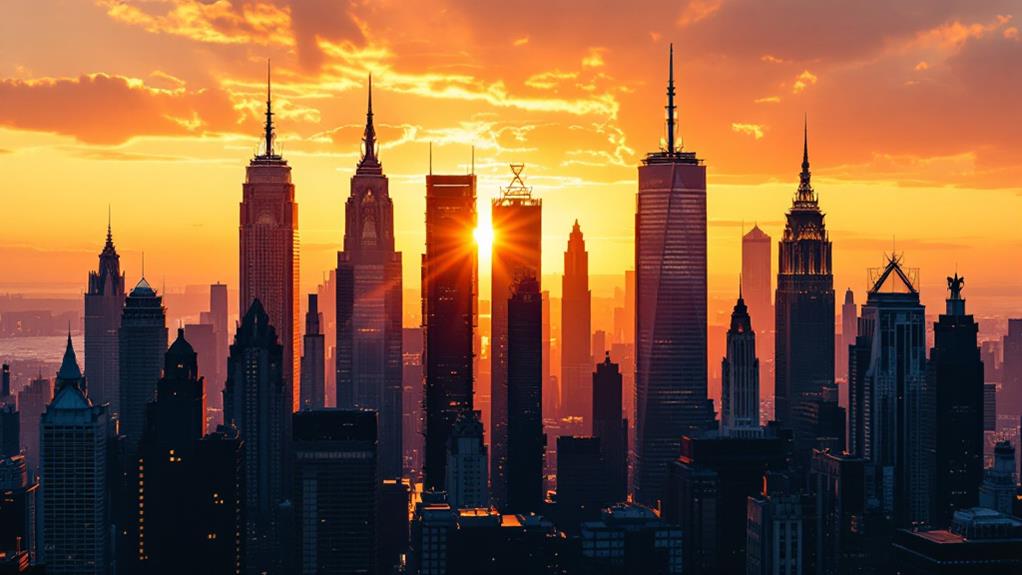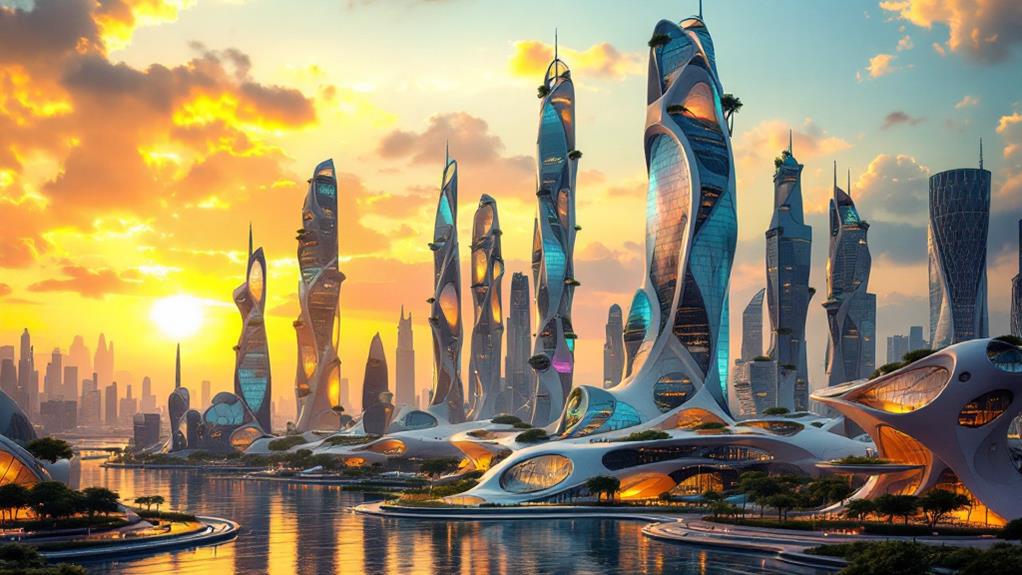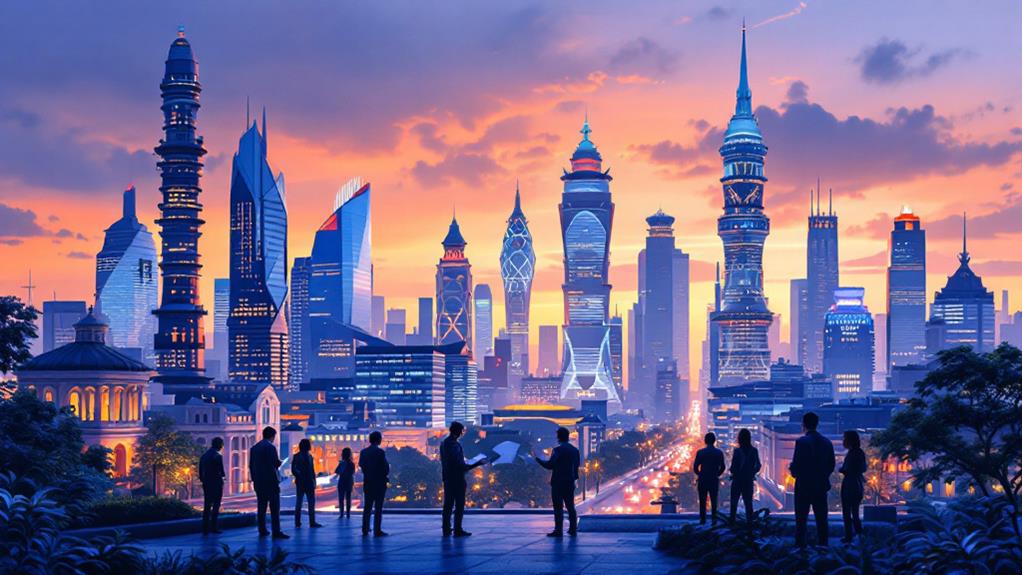Famous Architects Behind the Design of the Largest Buildings

You're about to uncover the celebrated architects responsible for the largest buildings in the world, where art meets structural innovation. Skidmore, Owings & Merrill LLP altered skyscraper design with the Willis Tower. Adrian Smith reached new heights with the Burj Khalifa, blending form and function. Césa Pelli's Petronas Towers transformed Malaysia's skyline through cultural motifs and engineering prowess. Pioneers like Frank Gehry and Santiago Calatrava redefine city landscapes with dynamic cultural landmarks while Kohn Pedersen Fox Associates push the envelope in skyscraper innovation. These architects continue to shape urban vistas in remarkable ways, revealing the endless possibilities they hold.
Visionaries of Skyscraper Architecture
In the domain of skyscraper architecture, certain visionaries have left an indelible mark on the urban skyline with their groundbreaking designs. When you think about the World Trade Center, you're reminded of Skidmore, Owings & Merrill LLP's pioneering perimeter tube design. This inventive approach enhanced office space and bolstered structural integrity, setting new standards in skyscraper safety and design. The World Trade Center stood as a reflection of how architectural innovation can reshape city landscapes while addressing practical concerns of space and safety.
Meanwhile, Césa Pelli's work on the Petronas Towers showcases another facet of visionary architecture. As the tallest buildings in the world from 1998 to 2004, the Petronas Towers not only reached new heights but also introduced unique height measurement methods. Pelli's design didn't just capture the imagination; it redefined what was possible in skyscraper construction. By integrating cultural symbolism and advanced engineering, the Petronas Towers exemplify how visionary architects can weave narrative and function into their towering creations.
Both the World Trade Center and the Petronas Towers illustrate how visionary architects challenge conventional boundaries, creating structures that enhance the urban experience and redefine the skyline.
Architects of Iconic Towers
While visionary architects have reshaped skylines with groundbreaking skyscrapers, the domain of iconic towers offers another perspective on architectural prowess. Take the Burj Khalifa, for example. Designed by Adrian Smith of Skidmore, Owings & Merrill, it's not just the world's tallest building; it's an architectural marvel at 2,717 feet. Its unique design, inspired by a lily flower, optimizes sunlight exposure for every office building within.
Then there's the Cayan Towers, also from Skidmore, Owings & Merrill. This tower stands out with its twisting design, rotating 90 degrees from base to top, and reaching a height of 1,010 feet. Its creative design redefines what's possible in residential architecture.
In Tokyo, the Tokyo Sky Tree, crafted by Nikken Sekkei, is the tallest freestanding tower globally, soaring to 2,080 feet. Its stability comes from a blend of reinforced concrete and steel tubes, demonstrating engineering brilliance.
Lastly, although not an office building, the Statue of Unity by Ram V. Sutar and the Millau Viaduct by Norman Foster and Michel Virlogeux showcase how towers can also serve cultural and functional purposes, blending art with engineering. These structures illuminate the endless possibilities of tower architecture.
Designers of Cultural Landmarks
As you investigate the domain of cultural landmarks, you'll uncover the transformative power of architecture in shaping human experience and identity. Among the most notable cultural landmarks, Frank Gehry's Walt Disney Concert Hall stands out with its dynamic stainless steel panels and groundbreaking acoustics, highlighting the deconstructivist approach in one of the most recognizable buildings in the world. Its design not only captivates visually but also enriches the auditory experience, making it a true masterpiece of modern architecture.
In Valencia, Santiago Calatrava's Palau de les Arts Reina Sofia emerges as a guiding light of advanced technology and striking design. This major performing arts facility seamlessly blends aesthetics with functionality, embodying the spirit of cultural landmarks across the globe.
The Museum of the Future in Dubai, crafted by Killa Design, presents a futuristic void shape adorned with Arabic poetry. It symbolizes progress and stands as a tribute to visionary architecture in one of the most iconic buildings in the world.
Jean Nouvel's design for the National Museum of Qatar draws inspiration from desert rose formations, merging cultural and historical narratives with unique architectural elements. Ultimately, Al Khazneh in Petra showcases the ancient Nabateans' artistic and architectural prowess, carved directly from sandstone.
Pioneers in Modern Engineering
Modern engineering's pioneers have left indelible marks on the skyline with their groundbreaking designs and inventive techniques. Frank Gehry's deconstructivist style shines in the Walt Disney Concert Hall, where stainless steel panels create a dynamic facade and a column-free auditorium improves audience connection. It's a confirmation of how architectural boundaries can be pushed.
Kohn Pedersen Fox Associates have made their mark by designing 16 of the world's largest skyscrapers. Their expertise in skyscraper innovation showcases how urban integration can be achieved without sacrificing design. Think of the breathtaking observation decks offering panoramic views from these towering structures.
Skidmore, Owings & Merrill LLP set new standards with their modernist and sustainable designs. The Willis Tower, with its bundled tube design, stands as a symbol of engineering prowess, increasing wind resistance and stability. It's a marvel in the world of skyscrapers.
César Pelli's Petronas Towers, once the world's tallest, used unique spire measurements, redefining height comparison. This landmark is another example of how engineering feats can reach new heights.
Santiago Calatrava's Palau de les Arts Reina Sofia merges advanced technology with artistic architecture, demonstrating the engineering magic behind major cultural edifices.
Innovators in Urban Development

The world of architectural innovation doesn't stop at individual skyscrapers; it extends into the domain of urban development. Imagine walking through a cityscape where every building tells a story of innovation and culture, shaped by visionary architects. Kohn Pedersen Fox Associates leads this narrative by seamlessly blending sustainable practices with towering designs. Their expertise is evident in their use of curtain walls, which allow natural light to flood the interiors of their skyscrapers, creating an eco-friendly environment.
Skidmore, Owings & Merrill LLP has reshaped urban skylines with their modernist approach, ensuring that each structure not only stands tall but also integrates with the city's fabric. Imagine visiting a lively exhibition centre designed by Aedas, where cultural relevance meets modern architecture. Aedas uses its global experience to enrich urban landscapes with designs that resonate culturally and functionally.
In Asia, Dennis Lau & Ng Chun Man Architects & Engineers craft high-rises that honor local traditions while embracing modernity. Meanwhile, Pelli Clarke Pelli Architects improves urban environments by prioritizing user experience, crafting skyscrapers that blend innovation with tradition. Each of these firms plays an essential role in transforming urban development into a sustainable and culturally rich experience.
Masters of Futuristic Structures
In the domain of futuristic structures, some architects push the boundaries of what's possible, transforming visions into reality. When you think of New York City's skyline, Kohn Pedersen Fox Associates comes to mind. They've designed 16 of the world's tallest buildings, showcasing their leadership in skyscraper innovation. Their work isn't just about height; it's about creating landmarks that redefine urban spaces.
Skidmore, Owings & Merrill LLP (SOM) is another key player, with 12 iconic skyscrapers to their name. They focus on sustainable design and integrating advanced technology, ensuring their creations stand the test of time. You see their influence in every sleek, modernist line that graces the horizon.
Aedas brings a unique touch to futuristic architecture by incorporating culturally relevant designs in their projects. Their international presence allows them to craft mixed-use structures that cater to diverse urban needs, creating spaces that feel alive and connected.
Dennis Lau & Ng Chun Man Architects & Engineers masterfully blend contemporary design with local traditions, particularly in Hong Kong. Meanwhile, Pelli Clarke Pelli Architects, founded by César Pelli, emphasizes urban integration, focusing on both user experience and aesthetic harmony, from New York City to the iconic Bay Sands.
Architects Revitalizing Cityscapes

Within the evolving urban landscape, architects play a crucial role in revitalizing cityscapes, breathing new life into aging areas. From an aerial view, you can see how Frank Gehry's dynamic designs, like the Walt Disney Concert Hall, transform urban environments and elevate cultural engagement. His work demonstrates how architecture can redefine spaces and attract people, invigorating the Real Estate market by making areas more desirable.
Kohn Pedersen Fox Associates have mastered this art with their groundbreaking skyscrapers, seamlessly blending them into urban settings. Their work not only revitalizes neighborhoods but also improves city skylines, offering a fresh perspective on modern architecture. Likewise, Santiago Calatrava's Palau de les Arts Reina Sofia in Valencia marries advanced technology and artistic vision, infusing cultural richness into the city's landscape.
Aedas incorporates local context in their designs, improving urban identity and vibrancy worldwide. Their culturally relevant structures invigorate cityscapes, highlighting the importance of context in architectural design. Meanwhile, Dennis Lau & Ng Chun Man Architects & Engineers elegantly fuse modern aesthetics with local traditions, particularly in Hong Kong, revitalizing urban areas and promoting sustainable growth. Through these architects, cityscapes are not just revitalized but reimagined.
Leaders in Sustainable Design
Sustainable design is reshaping the future of architecture, and several firms are leading the charge. Kohn Pedersen Fox Associates stands out with their commitment to sustainable skyscrapers. They incorporate energy-efficient systems and groundbreaking materials, as seen in projects like One Vanderbilt in New York City. Their designs aren't just about towering heights but also about minimizing environmental impact.
Skidmore, Owings & Merrill LLP has set a benchmark in sustainable architecture with their work on the LEED Platinum-certified Salesforce Tower in San Francisco. They focus on integrating modernist principles with sustainability, ensuring their buildings are both iconic and eco-friendly.
Aedas brings a unique approach by integrating local context and culture into their sustainable designs. Their emphasis on low-carbon materials and energy efficiency supports urban development worldwide, blending tradition with advancement.
Dennis Lau & Ng Chun Man Architects & Engineers excel in creating high-rises that respect local traditions while incorporating sustainable engineering solutions. Their designs are practical and environmentally conscious.
Pelli Clarke Pelli Architects focus on aesthetics and user experience, like incorporating roof gardens. Their energy-efficient technologies are evident in buildings like the Salesforce Tower, ensuring sustainability without compromising style. Marina Bay is another example where sustainable design and modern architecture merge effectively.



